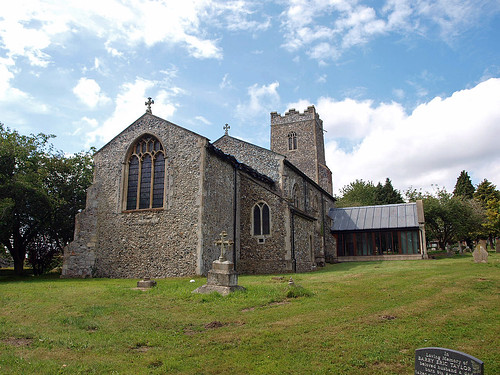ST MARY. Perp W tower-.* Nave and chancel. All details too renewed to be of value. - FONT. Octagonal, with shields in cusped fields. - BENCHES. With poppy-heads. One arm with an animal. - STAINED GLASS. E and W windows by Kempe, 1898 and 1902. - MONUMENT. Patience King, 1638. A curious tripartite tablet with two outer columns and two inner pilasters. Top with semicircular pediment between obelisks. In the three panels from l. to r. Mrs King and her daughters, Robert King, and a brass plate with three generations of Blandeviles, 'grandsyre, father and the son’. This brass plate was placed by Mrs King’s father Thomas Blandevile in 1571.
* Miss M. Sawbridge tells me that on the E side of the battlements, invisible from the ground, is an inscription to Ralph Bloudeville with the date 1503. Inside the tower is an original brick staircase.
NEWTON FLOTMAN. Thatched cottages straggle pleasantly along the road to its 17th-century bridge across the River Tas. The smithy and the gaunt mill by the bridge belong to neighbouring Saxlingham. From the bridge the old church at the other end of the village comes into the picture outlined against the sky, looking down on the winding stream. Like its embattled tower, most of it is 15th century, though 14th-century windows light the nave. The west window of the tower glows with rich glass. There is 15th-century tracery on the front of the pews, some of which have foliage poppyheads; we noticed a modern dog on an arm-rest facing an animal which has been here 500 years.
Three knights “who lived well and died well” are kneeling at prayer with open books, their small portraits engraved in brass in the chancel. All wear armour and have beards; they are three generations of the Blondevyles who were landowners here - Richard of 1490, Ralph of 1514, and Edward of 1568. Thomas Blondevyle brought fame into the family in Tudor days by writing books on such diverse subjects as horsemanship, navigation, science, and logic. It was he who set up this monument, and in its panels we see his kneeling figure sculptured in stone, his two wives and two small daughters in Elizabethan ruffs. One of the daughters has a memorial of her own close by; she was Patience King, and we read that she lived virtuously and died religiously.
A stone in the chancel brings to mind the thrilling story of a rector’s son, William Fortescue Long, who died far out in Melanesia in the year before the war. In the foower of his manhood he gave his life for a boy he was rescuing from drowning in the roaring surf off Norfolk Island. He was at the mission station, and the boy was one of a group of native schoolboys fishing in the tumultuous waters when he lost his balance on the rocks.
Three knights “who lived well and died well” are kneeling at prayer with open books, their small portraits engraved in brass in the chancel. All wear armour and have beards; they are three generations of the Blondevyles who were landowners here - Richard of 1490, Ralph of 1514, and Edward of 1568. Thomas Blondevyle brought fame into the family in Tudor days by writing books on such diverse subjects as horsemanship, navigation, science, and logic. It was he who set up this monument, and in its panels we see his kneeling figure sculptured in stone, his two wives and two small daughters in Elizabethan ruffs. One of the daughters has a memorial of her own close by; she was Patience King, and we read that she lived virtuously and died religiously.
A stone in the chancel brings to mind the thrilling story of a rector’s son, William Fortescue Long, who died far out in Melanesia in the year before the war. In the foower of his manhood he gave his life for a boy he was rescuing from drowning in the roaring surf off Norfolk Island. He was at the mission station, and the boy was one of a group of native schoolboys fishing in the tumultuous waters when he lost his balance on the rocks.

No comments:
Post a Comment